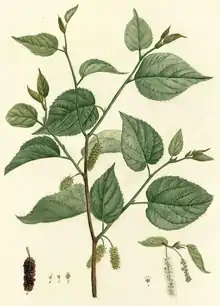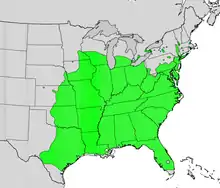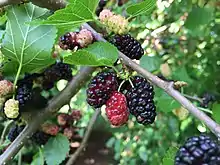Morus rubra
Morus rubra, commonly known as the red mulberry, is a species of mulberry native to eastern and central North America. It is found from Ontario, Minnesota, and Vermont south to southern Florida, and west as far as southeastern South Dakota, Nebraska, Kansas, and central Texas. There have been reports of isolated populations (very likely naturalized) in New Mexico, Idaho, and British Columbia.[2]
| Morus rubra | |
|---|---|
 | |
| 1809 illustration[1] | |
| Scientific classification | |
| Kingdom: | Plantae |
| Clade: | Tracheophytes |
| Clade: | Angiosperms |
| Clade: | Eudicots |
| Clade: | Rosids |
| Order: | Rosales |
| Family: | Moraceae |
| Genus: | Morus |
| Species: | M. rubra |
| Binomial name | |
| Morus rubra L. 1753 | |
 | |
| Native range | |
Common in the United States, it is listed as an endangered species in Canada,[3][4] and is susceptible to hybridization with the invasive white mulberry (M. alba), introduced from Asia.[5]
Description

Red mulberry is a deciduous tree, growing to 10–15 m (35–50 ft) tall, rarely 20 m (65 ft), with a trunk up to 50 cm (20 in) in diameter. It is a small to medium-sized[6] tree that reaches a height of 70 feet and lives up to 125 years.
The leaves are alternate, 7–18 cm (2 3⁄4–7 in) long (rarely to 36 cm or 14 1⁄4 in) and 8–12 cm (3 1⁄4–4 3⁄4 in) broad (about twice as big as the white mulberry's leaves),[3] simple, broadly cordate, with a shallow notch at the base, typically unlobed on mature trees although often with 2-3 lobes, particularly on young trees, and with a finely serrated margin.[3] Unlike the leaves of white mulberry (M. alba) which have a lustrous upper surface, the red mulberry leaf upper surface is noticeably rough, similar in texture to fine sandpaper, and the underside is densely covered with soft hairs.[7][8] The leaf petiole exudes milky sap when severed.[9] The leaves turn yellow in Autumn. Red mulberry is hardy to subzero temperatures, relatively hardy to drought, pollution, and poor soil, though the white mulberry is hardier.[10]
The flowers are relatively inconspicuous: small, yellowish green or reddish green and opening as leaves emerge. Male and female flowers are usually on separate trees although they may occur on the same tree.
The fruit is a compound cluster of several small achenes surrounded by a fleshy calyx, similar in appearance to a blackberry, 2–3 cm (3⁄4–1 1⁄4 in) long. It is initially pale green, ripening to red or dark purple.[3] The berries are widely sought after by birds in spring and early summer in North America; as many as 31 species of birds have been recorded visiting a fruiting tree in Arkansas.[11]
Uses
The berries are edible and very sweet.[3] The first English colonists to explore eastern Virginia in 1607 mentioned the abundance of both mulberry trees and their fruit, which was eaten (sometimes boiled) by the native Powhatan tribes. Today, mulberries are eaten raw, used in the fillings of pastries, and fermented into wine.
The wood may be dried and used for smoking meats with a flavor that is mild and sweet. Choctaw people wove clothing from the inner bark of young Morus rubra and similar shoots.[12]
References
- Duhamel du Monceau, H.L., Traité des arbres et arbustes, Nouvelle édition [Nouveau Duhamel], vol. 4: t. 23 (1809) [P.J. Redouté] drawing: P.J. Redouté lithograph Tassaert family: Moraceae subfamily: Moroideae tribe: Moreae 202746 ruber, rubra, rubrum 202746 ruber, rubra, rubrum Illustration contributed by: Real Jardín Botánico, Madrid, Spain
- "Morus rubra". County-level distribution map from the North American Plant Atlas (NAPA). Biota of North America Program (BONAP). 2014.
- Wunderlin, Richard P. (1997). "Morus rubra". In Flora of North America Editorial Committee (ed.). Flora of North America North of Mexico (FNA). 3. New York and Oxford – via eFloras.org, Missouri Botanical Garden, St. Louis, MO & Harvard University Herbaria, Cambridge, MA.
- Ambrose, J. D., & Kirk, D. (2004). National Recovery Strategy for Red Mulberry (Morus rubra L.). Ontario Ministry of Natural Resources, Guelph, Ontario, Canada
- Burgess, K. S.; Morgan, M.; Deverno, L.; Husband, B. C. (2005). "Asymmetrical introgression between two Morus species (M. alba, M. rubra) that differ in abundance" (PDF). Molecular Ecology. University of Toronto, Barrett Lab. 14 (17): 3471–3483. doi:10.1111/j.1365-294X.2005.02670.x. PMID 16156816. S2CID 31129733. Archived from the original (PDF) on 2008-02-21.
- https://www.nrcs.usda.gov/Internet/FSE_PLANTMATERIALS/publications/lapmcbr7910.pdf
- M. P. Nepal* and D. J. Wichern, "Taxonomic Status Of Red Mulberry (Morus Rubra, Moraceae) At Its Northwestern Boundary", Proceedings of the South Dakota Academy of Science, Vol. 92 (2013), p. 19 ff., http://sdaos.org/wp-content/uploads/pdfs/2013/19-29.pdf, accessed July 2019
- Farrar, J.L. (1995). Trees in Canada. Fitzhenry and Whiteside/Canadian Forest Service, Markham, Ontario.
- Trees of Alabama and the Southeast: Red Mulberry, Morus rubra, Moraceae.
- California Rare Fruit Growers
- Jackson, J. L. and R. Kannan. 2018. Avian frugivory in a fruiting mulberry tree (Morus rubra) in Arkansas. J. Arkansas Acad. Sci. 72:38-46. |https://scholarworks.uark.edu/cgi/viewcontent.cgi?article=3310&context=jaas
- Little, Elbert L. (1994) [1980]. The Audubon Society Field Guide to North American Trees: Western Region (Chanticleer Press ed.). Knopf. p. 426. ISBN 0394507614.
External links
- Interactive Distribution Map of Morus rubra
 Media related to Morus rubra at Wikimedia Commons
Media related to Morus rubra at Wikimedia Commons Data related to Morus rubra at Wikispecies
Data related to Morus rubra at Wikispecies

